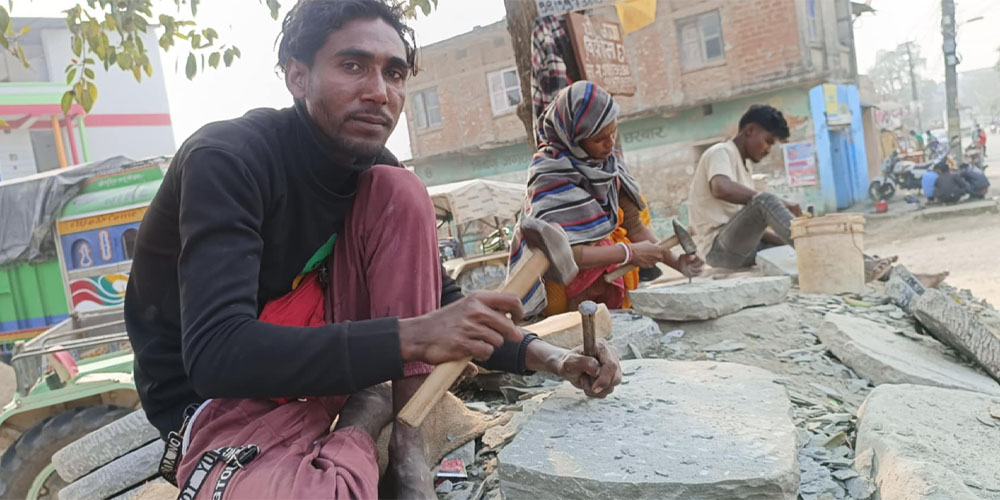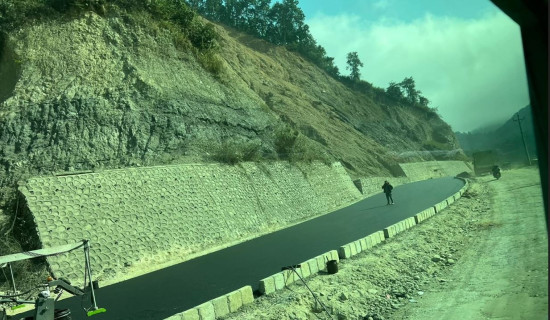- Sunday, 14 December 2025
The dying craft of millstones and grinding slabs
By Sudha Dev,Saptari, Feb. 13: The age-old tradition of grinding grains and spices on millstones and grinding slabs is gradually fading into obscurity.
With the advent of modern technology and the ever-increasing pace of daily life, the once-ubiquitous practice of using millstones and grinding slabs is steadily disappearing.
In Ward No. 2 of Rajbiraj Municipality, Lalbabu Sharma’s family has sustained itself for three generations by crafting and selling millstones, grinding slabs, and mortars. Even today, his household remains engaged in the meticulous art of shaping these traditional tools. However, his grandson, 35-year-old Shivji Sharma, laments that despite their unwavering dedication, sales have dwindled drastically over the years.
“My grandfather first began crafting millstones and grinding slabs in what was then Ward No. 9 of Rajbiraj Municipality, now Ward No. 2,” Shivji recounts. “For generations, we have carried forward this craft, but while my grandfather and father thrived in this trade, the demand has now dwindled. People rarely use these tools now, and when they do, a single purchase lasts for generations. As a result, sales have plummeted. Where once we would sell between four and seventy-eight pieces daily, we now struggle to sell even a single unit.”
Sales in urban areas have sharply declined, though demand persists in rural villages, allowing them to sustain the business thus far.
Shivji describes their enduring sales strategy: “On Saturdays and public holidays, we load our goods onto horses and travel from village to village, selling throughout the day before returning home.” He adds with a sigh, “Selling from the workshop itself has become nearly impossible, so we must venture out to find buyers.”
At present, a dozen family members remain engaged in this craft. While his father continues the trade in Rajbiraj, two uncles have taken their skills to Kanchanrup and Bhardaha, carving out a livelihood through the same means.
Depending on the craftsmanship and intricate detailing, a grinding slab sells for anywhere between Rs. 500 and Rs. 10,000, while a pair of millstones costs between Rs. 500 and Rs. 15,000. Mortars range from Rs. 300 to Rs. 1,500. “The more intricate the design, the more time and effort it demands, and accordingly, the price increases,” Shivji explains. However, custom orders requiring intricate detailing are few and far between.
Fifty-five-year-old Vimala Dev of Rajbiraj Municipality, Ward No. 16, reminisces about the days when she would grind spices and prepare pickles using a grinding slab, and mill grains in a millstone. “But for the past fifteen years, I have switched to electric mills and a mixer grinder at home,” she says.
She believes the changing times have led to this shift. “Women now juggle responsibilities both inside and outside home. With little time left for household chores, traditional grinding methods have naturally fallen out of favour,” she observes.
Similarly, fifty-year-old Durga Devi Rajak from Ward No. 1 of Rajbiraj supports her family by working in other households. “Since we have a mixer grinder at work, I use it for grinding spices and other ingredients,” she shares. “But at home, I still prefer using the traditional grinding slab.”
According to her, families that own electric grinders only resort to using millstones and grinding slabs during power cuts or when their machines break down.
Shivji’s father, Rajkumar Sharma, echoes these sentiments: “This trade barely sustains us anymore. We have no alternative. If we abandon this ancestral profession, who will continue it?” He speaks with resignation, acknowledging that despite their reluctance, they are bound to this livelihood. “But given the shifting circumstances, it is increasingly difficult to make ends meet solely through this trade.”
Rajkumar’s three sons, who began learning the craft at ages nine and ten, have continued in the family’s footsteps. While they possess basic literacy, their commitment to preserving the family trade has kept them bound to the craft.
Despite three generations of dedication to this profession, declining demand has led the family to rethink its future. “We are now considering providing higher education for our children, so they have opportunities beyond this trade,” Shivji reveals.
















